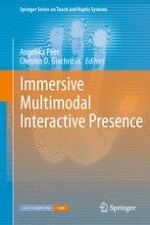
2012 | OriginalPaper | Buchkapitel
5. Psychological Experiments in Haptic Collaboration Research
verfasst von : Raphaela Groten, Daniela Feth, Angelika Peer, Martin Buss
Erschienen in: Immersive Multimodal Interactive Presence
Verlag: Springer London
Aktivieren Sie unsere intelligente Suche, um passende Fachinhalte oder Patente zu finden.
Wählen Sie Textabschnitte aus um mit Künstlicher Intelligenz passenden Patente zu finden. powered by
Markieren Sie Textabschnitte, um KI-gestützt weitere passende Inhalte zu finden. powered by